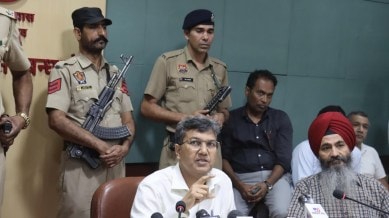Stay updated with the latest - Click here to follow us on Instagram
Floods In Punjab | Beas water inflow highest ever, was forced to release water downstream: BBMB chairman
The BBMB is facing brickbats from the political parties in Punjab and in Himachal Pradesh, who have accused the authorities of releasing excess water downstream leading to flooding in the two states.

Amid unprecedented rainfall in its catchment areas, the Beas river in Himachal Pradesh recorded its highest-ever inflow of water at 11.70 billion cubic meters (BCM) between July 1 and September 5, Bhakra Beas Management Board (BBMB) chairperson Manoj Tripathi Friday said. Pong dam, built on Beas, has a capacity of only 5.5 BCM, he said, adding the BBMB was forced to release excess water downstream.
The BBMB is facing brickbats from the political parties in Punjab and in Himachal Pradesh, who have accused the authorities of releasing excess water downstream leading to flooding in the two states.
monthly limit of free stories.
with an Express account.
Speaking to the media, Tripathi said that that Punjab has experienced heavy rainfall four times since 1988, but this year’s deluge is unparalleled.
“This year we saw historically highest ever water inflow in Beas river. From July 1 to September 5, the inflow in Beas was 11.70 BCM. Comparatively, in 2023, when too Punjab had faced floods, it was 9.52 BCM. During the 1988 floods, it was 7.94 BCM, and 5 BCM in 2019. What we saw this year is called unprecedented flow. Never before has Beas river seen such flow,” Tripathi said.
He said Bhakra dam, built on river Sutlej, too received one of the highest inflows, although not unprecedented. “This year, it received 9.11 bcm, and before this, 9.52 bcm and 9.45 bcm in 1988,” he said.
The two dams, both managed by BBMB, have a huge carrying capacity. “Had it not been for the dams, Punjab would have faced floods as early as June due to the extraordinary rainfall. At its peak, the Pong dam’s catchment area received 220,000 cusecs of water in a single day, while Bhakra received 110,000 cusecs,” he added.
Tripathi further said that accumulation of silt in Bhakra and Pong dams was creating an obstacle in effective water management. Blaming the governments of partner states for not allowing dams to be emptied for desilting, he said, “In Bhakra dam alone, 25 per cent of capacity is occupied by silt. Desilting requires a coordinated action. Unless, the states allow emptying of the dams, desilting cannot be completed. I had tried earlier and raised the issue with the Himachal Pradesh government last year, urging them to take action. But the state’s department of mining objected to it. Now, they have agreed. Hopefully, things will change now”.
On a narrative gaining ground that BBMB had caused floods due to poor management, he said the state governments are informed in advance about water release based on forecast from the Indian Meteorological Department and the Global Forecast System. Tripathi emphasized that the state governments are responsible for reinforcing river embankments to prevent flooding.
In view of the heavy rainfall this monsoon, Tripathi said the BBMB will urge the partner states to come out of a “conservative approach” on insisting that water level in the reservoirs be maintained till a certain limit despite early forecasts predicting above normal monsoon this year.
Earlier this year, before the beginning of the monsoon, Punjab and Haryana had been at loggerheads over the distribution of water. Punjab’s AAP government had refused to share water from the Bhakra dam, saying the neighbouring state has already utilised its share of water.
Citing the dispute, the BBMB chairman was asked if Punjab had released extra water to Haryana, would it have prevented the floods in the state? “That would have only lowered the dam level by three feet. This would have been insignificant compared to the actual inflow,” he said.
On being asked if one can hope the worst is over, the Board chairman said, “No severe category of rain is likely to happen in catchment areas… HP is the catchment area of both these rivers (Sutlej and Beas) in coming days, though there is a slight event on September 7; thereafter, dry weather has been predicted over next coming week.”
On the ongoing dispute between Punjab and BBMB over deploying the Central Industrial Security Force (CISF) at BBMB projects, Tripathi said that such decisions cannot be withdrawn unilaterally as this was taken in consultation with all partner states in 2021. He said, “Why are they asking for its withdrawal now? They had 2022, 2023, 2024. There was no objection. The deployment began in Sundernagar and was planned for Bhakra and Nangal this year”.
Refuting Punjab Chief Minister Bhagwant Mann’s claims that Punjab bears 60 per cent of the costs, Tripathi said the state’s share is only 39 per cent. “Rajasthan contributes 27 per cent and Haryana 29 per cent. The CISF is a superior force compared to the Punjab Police. This would also mean higher expense,” he added.